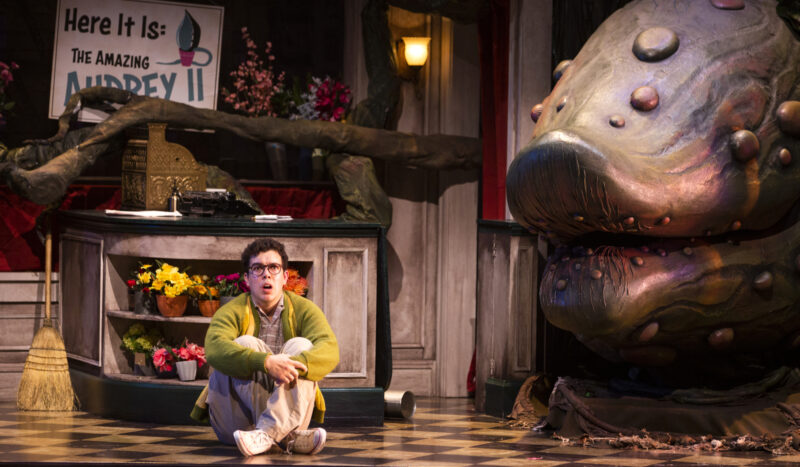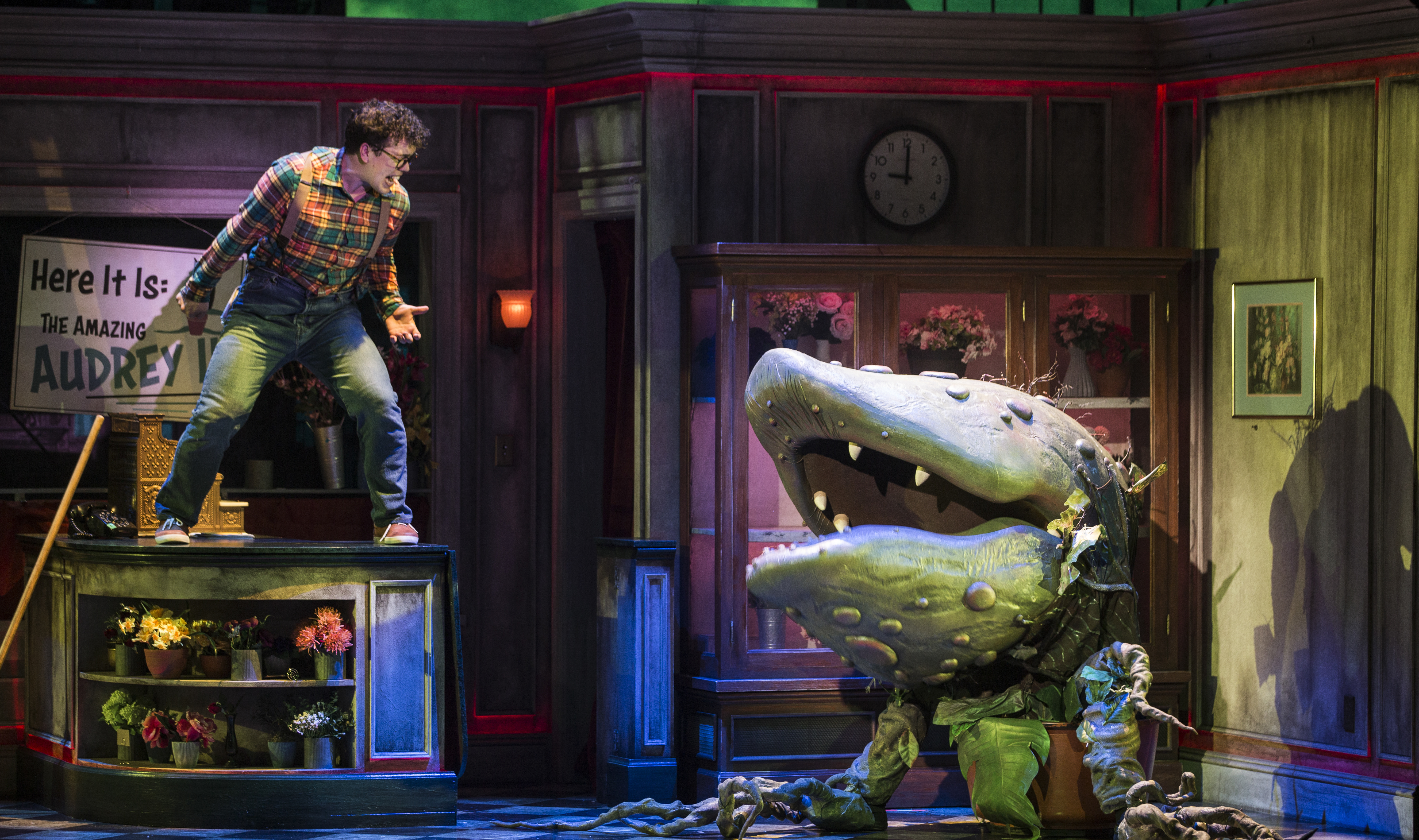Thumb Too Green
Review of Little Shop of Horrors at the Village Theatre
Written by Teen Writer Elle Vonada and edited by Teen Editor Kyle Gerstel

Warning: Spoilers ahead!
Village Theatre’s production of Little Shop of Horrors brings the classic horror comedy to life through thoughtful set design, choreography, and blocking. Little Shop of Horrors opened in 1982 as an off Broadway production with book and lyrics by Howard Ashman and a score by Alan Menken. Broke botanist Seymour Krelborn (Kyle Nicholas Anderson) has a breakthrough growing a fantastical plant. Seymour thinks his financial issues have been resolved when the plant attracts customers to the store he works at, Mushnik’s Flower Shop. However, the plant grows a mind of its own, and things go awry.
Seymour names the plant Audrey II, after his crush, Audrey (Shanelle Nicole Leonard). Despite Seymour’s desperate attempts to get Audrey to notice him, she is occupied by her abusive boyfriend, Orin Scrivello (Nick Watson), who flaunts his esteemed title of D.D.S. (Doctor of Dental Surgery). Watson as Scrivello horrifically displays the pernicious effects of misogyny in abusive relationships. Leonard chillingly depicts the unfortunate reality of being on the receiving end of abuse.
The majority of the play takes place in Mushnik’s Flower Shop in Skid Row, New York City. The shop occupies most of the stage, with the old apartment buildings of Skid Row just outside. Scene changes were seamless, with crew members never missing a beat alongside intricate technical coordination. The simplicity of the set allowed the actors to move dynamically while singing and dancing. Scenic Designer Timothy Mackabee allows movement above the stage, utilizing scaffolding as an additional part of the set so actors can watch Mushnik’s Flower Shop from above. This choice put distance between Audrey II and those singing, both physically and metaphorically.

Choreographer Randy Ford consistently mirrored the choreography to the catchy score, making the material and staging feel uniform. For example, I heard hints of Argentinian music in several numbers and felt satisfied when the actors began to tango. Additionally, Music Directors Aaron M. Davis Norman and Tim Symons polished the performance with gorgeous harmonies. Puppeteer John David Scott beautifully manipulates Audrey II to be full of attitude. Kennedy Salters brought Audrey II to life as the plant’s offstage voice (Salters has been replaced by Lisa Estridge for the production’s remaining performances). Together, Salters and Scott humanized the plant, making its thirst for blood even more terrifying.
Confronting the delicate issue of domestic abuse is not a task one should take on lightly. Intense imagery of abuse is depicted onstage and details are discussed involving the extent of everything Audrey endures outside of what the audience witnesses. Watson fulfills the script’s portrayal of Scrivello as a person the audience can easily hate.
Scrivello’s crass comments and manipulative power dynamics are characteristics many women who have suffered domestic abuse can recognize. Keeping that in mind, providing a trigger warning before each performance or in the playbill is a respectful idea for the audience. Village Theatre’s website includes the note, “This production of Little Shop of Horrors contains guns, machetes, infectious tunes, and carnivorous plants,” but lacks any warning about domestic abuse. I appreciate the closure Audrey had with Seymour when discussing Scrivello’s demise. However, it felt like Audrey’s abuse and the relief of it was out of her control and she needed a man, Seymour, to resolve it for her. Is that a message that should be promoted in this patriarchal time?
The musical’s story is based on the 1960 non-musical film The Little Shop of Horrors, written by Charles B. Griffith and directed by Roger Corman. Ashman tweaked Griffith’s original script, but the piece lacks modernization in terms of language and heteronormativity sprinkled throughout. One example of problematic wording was the repeated referral of grown women as “girls.” I found it particularly uncomfortable to see white or white-passing men addressing the women in the show as "girls” since the female characters were all played by people of color. The production illustrates intersectional discrimination but fails to comment on it, which makes the dialogue unsettling and patronizing. When producing a show that originated in the 1980s, it is crucial to assess the political situations that were taking place and the oppression current audience members are still affected by. The racism and misogyny that were extremely prevalent in the ‘80s still impact minorities in 2022.
The eventual triumph of Audrey II and the barbarism she represents was a long time coming. Audrey II watches as characters demonstrate their rottenness and punishes them accordingly. Scrivello is the first life Audrey II takes. His early demise is caused by his blatantly appalling behavior. Seymour’s boss Mr. Mushnik (Eric Polani Jensen) contorts his relationship with Seymour for his personal gain; Mushnik knows Seymour lacks a father figure and adopts him to ensure Audrey II stays in his shop and continues to attract customers. Eventually, Audrey II eats him. Finally, Seymour abuses his relationship with Audrey II for his personal gain and eventually becomes obsolete in her uprising. He and Audrey, the person who means the most to him in the world, are consumed. The show closes with Audrey II saying she will disperse her spores of flesh-eating plants, thus ending the hideousness of the human condition. I feel this is the most logical outcome of the experiment of humanity’s existence—nature taking back its home.
Little Shop of Horrors took place at the Village Theatre on September 14 — October 23, 2022. For more information see here.
Lead Photo: Kyle Nicholas Anderson in Village Theatre’s Little Shop of Horrors. Photos by Angela Sterling.
The TeenTix Newsroom is a group of teen writers led by the Teen Editorial Staff. For each review, Newsroom writers work individually with a teen editor to polish their writing for publication. The Teen Editorial Staff is made up of 6 teens who curate the review portion of the TeenTix blog. More information about the Teen Editorial Staff can be found HERE.
The TeenTix Press Corps promotes critical thinking, communication, and information literacy through criticism and journalism practice for teens. For more information about the Press Corps program see HERE.


